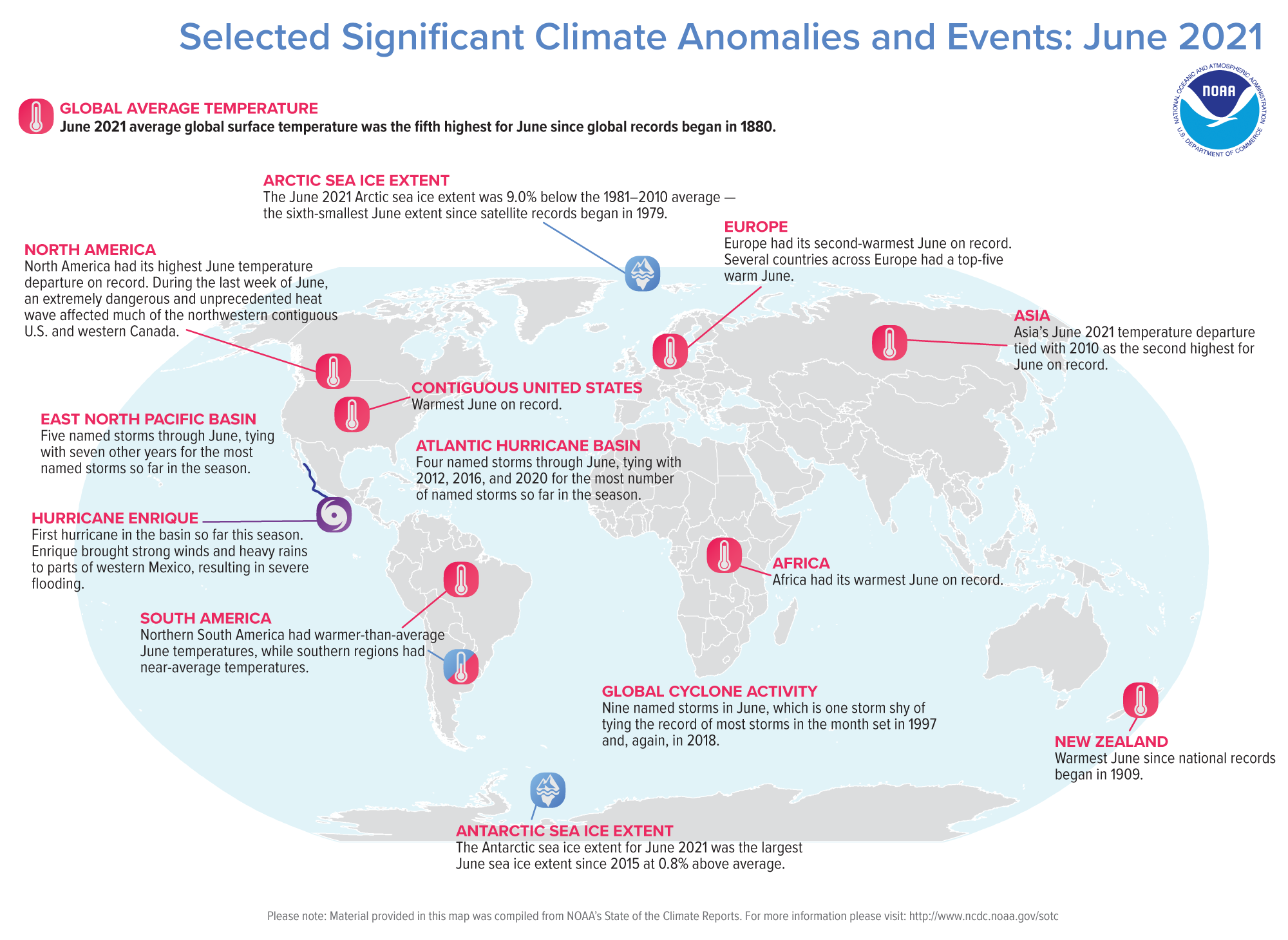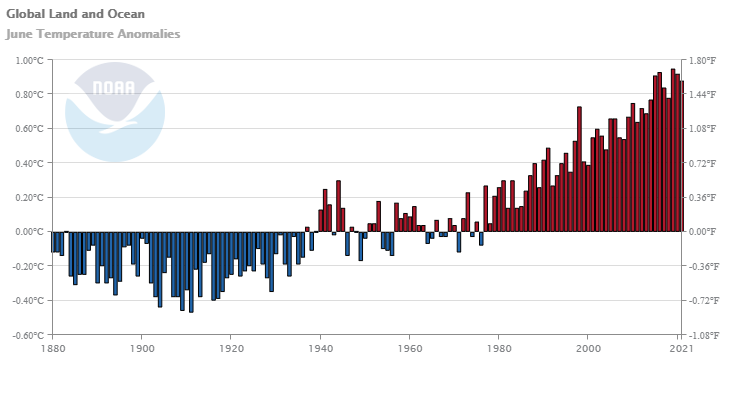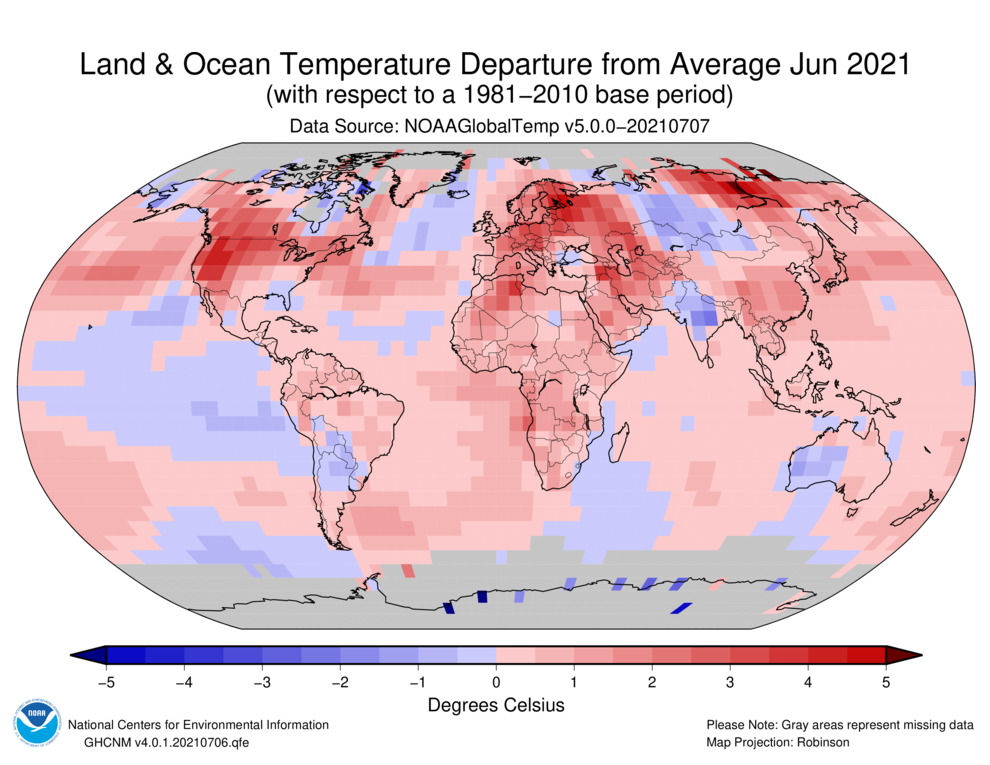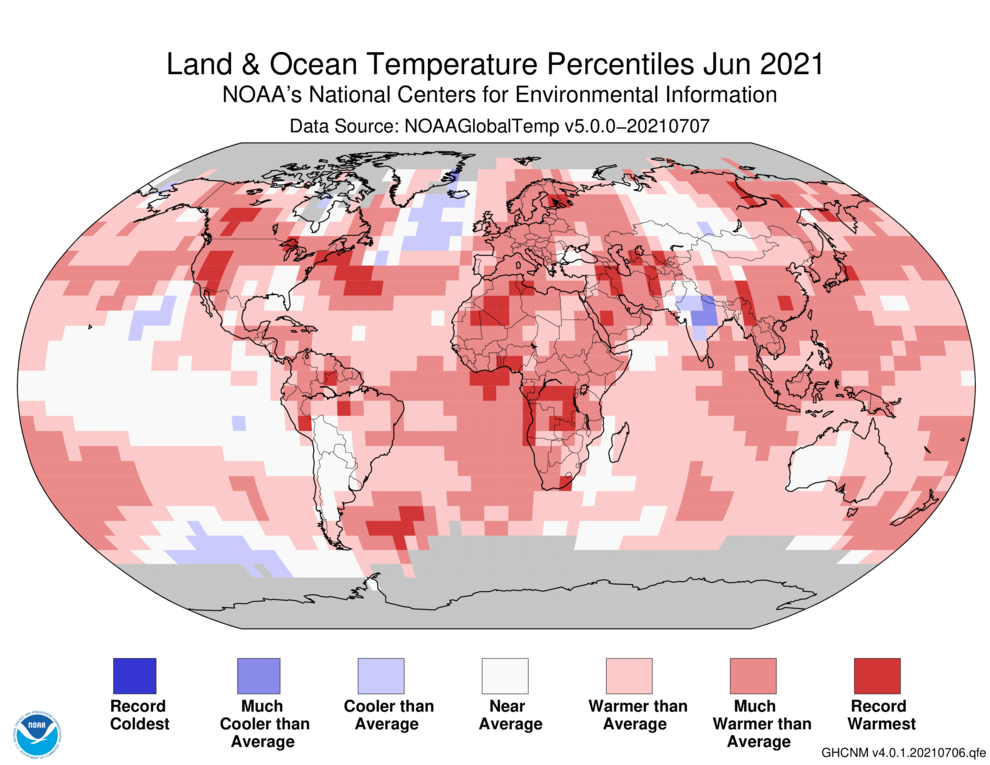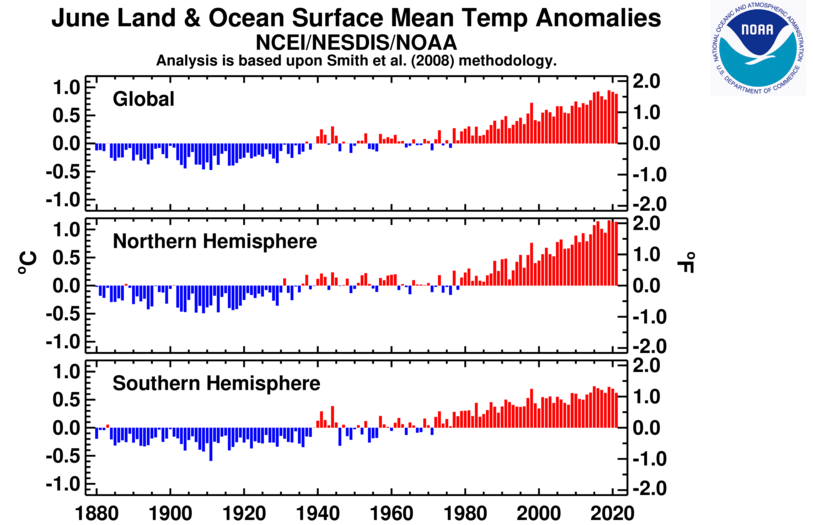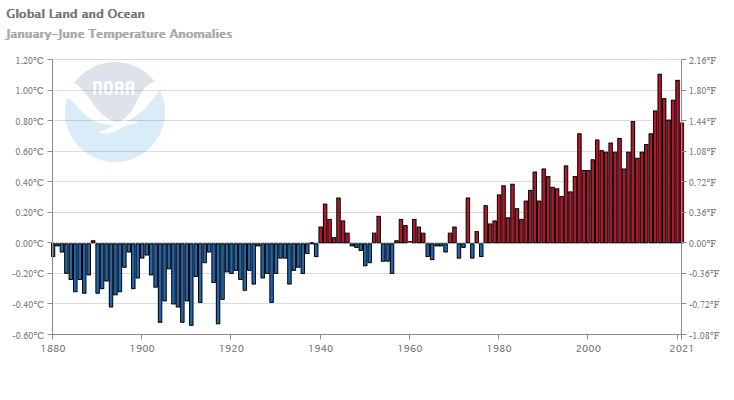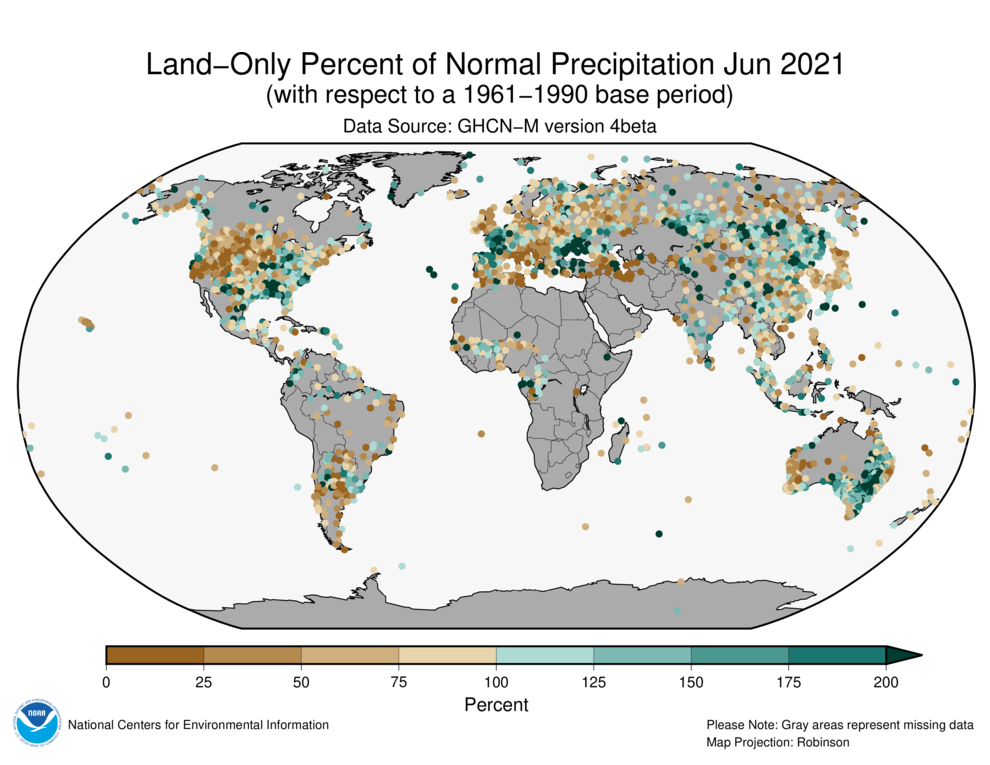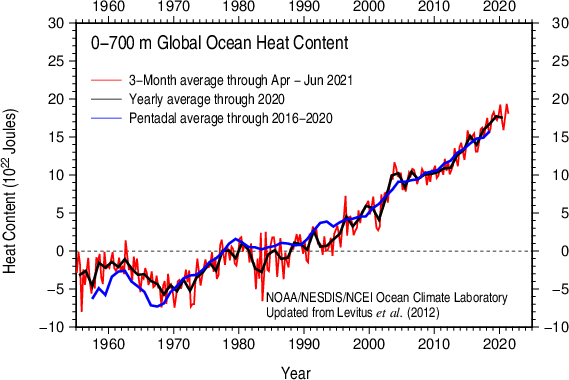Introduction
Temperature anomalies and percentiles are shown on the gridded maps below. The anomaly map on the left is a product of a merged land surface temperature (Global Historical Climatology Network, GHCN) and sea surface temperature (ERSST version 5) anomaly analysis. Temperature anomalies for land and ocean are analyzed separately and then merged to form the global analysis. For more information, please visit NCEI's Global Surface Temperature Anomalies page. The percentile map on the right provides additional information by placing the temperature anomaly observed for a specific place and time period into historical perspective, showing how the most current month, season or year compares with the past.
Temperature
In the atmosphere, 500-millibar height pressure anomalies correlate well with temperatures at the Earth's surface. The average position of the upper-level ridges of high pressure and troughs of low pressure—depicted by positive and negative 500-millibar height anomalies on the June 2021 is generally reflected by areas of positive and negative temperature anomalies at the surface, respectively.
Monthly Temperature: June 2021
The June 2021 global surface temperature was the fifth highest for June in the 142-year record at 0.88°C (1.58°F) above the 20th century average. Only Junes of 2015 (fourth warmest), 2016 (second warmest), 2019 (warmest), and 2020 (third warmest) were warmer and had a global temperature departure above +0.90°C (+1.62°F). Nine of the 10 warmest Junes have occurred since 2010. June 1998 is the only June from the previous century among the 10 warmest Junes on record, and currently ranks as the tenth warmest June on record. June 2021 also marked the 45th consecutive June and the 438-consecutive month with temperatures, at least nominally, above the 20th century average.
Much of the globe experienced warmer-than-average conditions, with temperature departures of at least +3.0°C (+5.4°F) across large portions of the Northern Hemisphere land, specifically across parts of North America, Europe, and western and central Russia. The North Pacific Ocean and parts of the Atlantic Ocean had temperatures that were at least 2.0°C (3.6°F) above average. Record-warm June temperature departures were observed across parts of North America, the Atlantic Ocean, Africa, Asia, and northern South America. Record-warm June temperatures encompassed 4.18% of the world's surface. This was the sixth highest June percentage since records began in 1951.
The global land-only surface temperature for June 2021 was the highest on record at 1.42°C (2.56°F) above average. This value surpassed the previous record set in 2019 by +0.11°C (+0.20°F). The ten warmest June global land-only surface temperatures have occurred since 2010. The unusually warm June global land-only surface temperature was mainly driven by the very warm Northern Hemisphere land, which also had its highest June temperature departure at +1.69°C (+3.04°F). The now second highest June temperature for the Northern Hemisphere occurred in 2012 (+1.51°C / +2.72°F).
Meanwhile, near- to cooler-than-average June temperatures were present across parts of the central and eastern tropical Pacific Ocean, as well as parts of the southeastern Pacific Ocean, northeastern Canada, southern South America, the northern Atlantic Ocean, central Asia, and western Australia. However, no land or ocean areas had a record cold June temperature.
North America, as a whole, had its highest June temperature on record at 1.98°C (3.56°F) above average. This was 0.30°C (0.54°F) higher than the now second warmest June set in 2016. Nine of the ten warmest Junes for North America have occurred since 2006, with June of 1988 ranking among the ten warmest on record. During the last week of June, an extreme heat wave affected much of the northwestern contiguous U.S. and western Canada with maximum (daytime) temperatures surpassing 38.0°C (100°F), which is not typical for the region. Maximum temperatures were at least 16.0°C (28.8°F) above average across the region. According to the World Meteorological Organization, Lytton, British Columbia, Canada, set a new national maximum temperature record for three consecutive days. The latest record was 49.6°C (121.3°F) set on June 29, which is a maximum temperature more typical of summer temperatures in the Middle East. The intense heat was blamed for over 100 reported deaths and hospitalizations related to the heat across Western Canada. In the U.S., preliminary reports stated that the heat affected crops such as berries and wheat. For the contiguous U.S., the June 2021 temperature was the highest for June in the nation's 127-year record, with a temperature that was 4.2°F (2.3°C) above the 20th century average. This value bested the previous record set in 2016 by a wide margin of +0.9°F (+0.5°C). Several states across the West and the Northeast had a record warm or near-record warm June temperature.
Africa's June 2021 temperature was 1.44°C (2.59°F) above average—the warmest June on record. This surpassed the previous record set only last year (2020) by 0.07°C (0.13°F). The last three Junes (2019, 2020, and 2021) are Africa's three warmest Junes on record, with nine of the 10 warmest Junes occurring since 2009.
Europe also experienced an unusually warm June, resulting in its second warmest June on record with a temperature departure of +2.36°C (4.25°F). This was 0.57°C (1.03°F) cooler than the record-warm June set in 2019. Several countries across Europe had a top five warm June. De Bilt, Netherlands had its highest June temperature since national records began in 1901 at 2.0°C (3.6°F) above average. Austria, as a whole, had its third warmest June in the nation's 254-year record, behind 2003 (second warmest) and 2019 (warmest). According to ZAMG, eight of Austria's 10 warmest Junes have occurred since 2010. Finland had its warmest June on record with a temperature of 16.5°C (61.7°F), surpassing the previous record set in 1953 by 0.3°C (0.5°F). Helsinki, Finland's capital, had an average temperature of 19.3°C (66.7°F), which was its highest June temperature since records began in 1844. Norway had its fifth warmest June since national records began in 1900, with a June temperature that was 2.3°C (4.1°F) above average. Switzerland's June 2021 national temperature tied with 2002 as the fourth warmest June since records began 1864.
Asia, as a whole, had a temperature that was 1.50°C (2.70°F) above average, tying with 2010 as the second highest June temperature on record. This was also only 0.28°C (0.50°F) shy of tying the record warm June set in 2012. Asia's ten warmest Junes have all occurred since 2006.
South America and Oceania also had an above-average June temperature; however, their temperature departure didn't rank among the ten warmest on record. According to NIWA, New Zealand had its warmest June since national records began in 1909. The nation's temperature for June 2021 was 2.0°C (3.6°F) above average.
| June | Anomaly | Rank (out of 142 years) | Records | ||||
|---|---|---|---|---|---|---|---|
| °C | °F | Year(s) | °C | °F | |||
| Global | |||||||
| Land | +1.42 ± 0.19 | +2.56 ± 0.34 | Warmest | 1st | 2021 | +1.42 | +2.56 |
| Coolest | 142nd | 1907 | -0.66 | -1.19 | |||
| Ocean | +0.68 ± 0.14 | +1.22 ± 0.25 | Warmest | 6th | 2016 | +0.82 | +1.48 |
| Coolest | 137th | 1911 | -0.49 | -0.88 | |||
| Ties: 2014 | |||||||
| Land and Ocean | +0.88 ± 0.15 | +1.58 ± 0.27 | Warmest | 5th | 2019 | +0.95 | +1.71 |
| Coolest | 138th | 1911 | -0.47 | -0.85 | |||
| Northern Hemisphere | |||||||
| Land | +1.69 ± 0.20 | +3.04 ± 0.36 | Warmest | 1st | 2021 | +1.69 | +3.04 |
| Coolest | 142nd | 1907 | -0.77 | -1.39 | |||
| Ocean | +0.80 ± 0.14 | +1.44 ± 0.25 | Warmest | 7th | 2019 | +1.04 | +1.87 |
| Coolest | 136th | 1904 | -0.53 | -0.95 | |||
| Land and Ocean | +1.14 ± 0.17 | +2.05 ± 0.31 | Warmest | 3rd | 2019 | +1.16 | +2.09 |
| Coolest | 140th | 1909 | -0.49 | -0.88 | |||
| Ties: 2020 | |||||||
| Southern Hemisphere | |||||||
| Land | +0.76 ± 0.11 | +1.37 ± 0.20 | Warmest | 12th | 2015 | +1.24 | +2.23 |
| Coolest | 131st | 1885 | -1.03 | -1.85 | |||
| Ties: 1992 | |||||||
| Ocean | +0.59 ± 0.15 | +1.06 ± 0.27 | Warmest | 8th | 2016 | +0.71 | +1.28 |
| Coolest | 135th | 1911 | -0.51 | -0.92 | |||
| Ties: 2020 | |||||||
| Land and Ocean | +0.62 ± 0.15 | +1.12 ± 0.27 | Warmest | 8th | 2015 | +0.74 | +1.33 |
| Coolest | 135th | 1911 | -0.59 | -1.06 | |||
| Ties: 2009, 2018 | |||||||
| Arctic | |||||||
| Land and Ocean | +1.61 ± 0.23 | +2.90 ± 0.41 | Warmest | 6th | 2016 | +2.03 | +3.65 |
| Coolest | 137th | 1886 | -1.39 | -2.50 | |||
The most current data can be accessed via the Global Surface Temperature Anomalies page.
Year-to-date Temperature: January–June 2021
The global surface temperature during the first half of the year was 0.79°C (1.42°F) above average and was the eighth warmest such period since global records began in 1880. Looking ahead, the year 2021 is very likely to rank among the ten warmest years on record, according to a statistical analysis done by NCEI scientists.
The first half of the year was characterized by warmer-than-average conditions across much of the globe. Record-warm January–June temperatures were observed across parts of the southern half of Asia, northern Africa, and across parts of the Pacific and Atlantic oceans. Near- to cooler-than-average January–June temperatures were present across parts of the central and eastern tropical Pacific Ocean as well as the southeastern Pacific Ocean, the northern Atlantic Ocean, and parts of northern Asia, as well as India, and Australia. However, no land or ocean areas had a record-cold January–June temperature.
The January–June 2021 temperature for Africa was 1.32°C (2.38°F) above average, resulting in the third warmest such period on record. Only 2010 and 2016 were warmer. Asia had its eighth warmest January–June period on record. According to the Hong Kong Observatory, Hong Kong had its warmest January–June period on record. South America had its tenth warmest (tied with 2013) year-to-date on record in the 112-year continental record, while North America had its 11th warmest (tied with 1999).
| January–June | Anomaly | Rank (out of 142 years) | Records | ||||
|---|---|---|---|---|---|---|---|
| °C | °F | Year(s) | °C | °F | |||
| Global | |||||||
| Land | +1.30 ± 0.17 | +2.34 ± 0.31 | Warmest | 6th | 2016 | +1.85 | +3.33 |
| Coolest | 137th | 1893 | -0.88 | -1.58 | |||
| Ocean | +0.60 ± 0.17 | +1.08 ± 0.31 | Warmest | 8th | 2016 | +0.84 | +1.51 |
| Coolest | 135th | 1904, 1911 | -0.50 | -0.90 | |||
| Land and Ocean | +0.79 ± 0.17 | +1.42 ± 0.31 | Warmest | 8th | 2016 | +1.11 | +2.00 |
| Coolest | 135th | 1911 | -0.54 | -0.97 | |||
| Northern Hemisphere | |||||||
| Land | +1.53 ± 0.20 | +2.75 ± 0.36 | Warmest | 6th | 2016 | +2.10 | +3.78 |
| Coolest | 137th | 1893 | -0.99 | -1.78 | |||
| Ocean | +0.73 ± 0.16 | +1.31 ± 0.29 | Warmest | 7th | 2016, 2020 | +0.95 | +1.71 |
| Coolest | 136th | 1904 | -0.52 | -0.94 | |||
| Land and Ocean | +1.04 ± 0.17 | +1.87 ± 0.31 | Warmest | 6th | 2016 | +1.39 | +2.50 |
| Coolest | 137th | 1893 | -0.64 | -1.15 | |||
| Southern Hemisphere | |||||||
| Land | +0.69 ± 0.14 | +1.24 ± 0.25 | Warmest | 17th | 2019 | +1.28 | +2.30 |
| Coolest | 126th | 1917 | -0.87 | -1.57 | |||
| Ocean | +0.51 ± 0.17 | +0.92 ± 0.31 | Warmest | 11th | 2016 | +0.77 | +1.39 |
| Coolest | 132nd | 1911 | -0.52 | -0.94 | |||
| Ties: 2003 | |||||||
| Land and Ocean | +0.54 ± 0.17 | +0.97 ± 0.31 | Warmest | 13th | 2016 | +0.84 | +1.51 |
| Coolest | 130th | 1911 | -0.54 | -0.97 | |||
| Arctic | |||||||
| Land and Ocean | +1.19 ± 0.20 | +2.14 ± 0.36 | Warmest | 19th | 2016 | +2.93 | +5.27 |
| Coolest | 124th | 1902 | -1.61 | -2.90 | |||
Precipitation
June Precipitation
The maps shown below represent precipitation percent of normal (left, using a base period of 1961–1990) and precipitation percentiles (right, using the period of record) based on the GHCN dataset of land surface stations. As is typical, precipitation anomalies during June 2021 varied significantly around the world.
In the contiguous U.S., drought affected much of the West, the northern High Plains, the Great Lakes region, as well as the Northeast. As of 29 June 2021, a little over half of the western U.S. was entrenched in severe to exceptional drought. According to the U.S. Drought Monitor, the unprecedented heat wave that affected much of the northwestern contiguous U.S. and western Canada at the end of the month, helped deteriorate drought conditions by increasing evaporative demand, drying out soils and vegetation, as well as straining water resources. In fact, the Northern Rockies and Plains region had its driest June in the 127-year record. Across western Canada, the warm and dry conditions during the end of the month contributed to the development of numerous wildfires in the region. Of note, the village of Lytton, British Columbia, Canada, had a devastating wildfire that forced the evacuation of residents.
The Atlantic hurricane basin has been active so far this season, with three tropical storms forming in June. Of note, Tropical Storm Claudette, which made landfall in Louisiana, U.S., on June 19, brought torrential rains, floods, and spawned a few tornadoes in the southeastern region. Claudette contributed to the wetter-than-average conditions across the southeastern contiguous U.S., especially across Alabama and Mississippi, which had their second and fifth wettest June on record. Before becoming a tropical storm, the disturbance that later became Tropical Storm Claudette brought heavy rain to parts of eastern and southern Mexico, prompting mudslides and overflowing rivers. Parts of eastern Mexico had twice their June normal precipitation.
The Eastern North Pacific hurricane basin also had an above-average tropical storm activity. Of note were Tropical Storm Dolores and Hurricane Enrique, which affected parts of western Mexico with its strong winds, heavy rain, and flash floods.
According to Spain's Agencia Estatal de Meteorología, the month of June 2021 was wetter-than-average with a national precipitation of 147% of normal.
Australia had 15% above-average June precipitation during the month. However, regional differences were observed. Much of Western Australia had drier-than-average conditions, with a deficit for the region of 32% below average. Meanwhile, eastern Australia had wetter-than-average conditions during the month, with the Northern Territory (56% above average), Queensland (+53%), and New South Wales (+65%) having the largest departure from average.
Global Precipitation Climatology Project (GPCP)
The following analysis is based upon the Global Precipitation Climatology Project (GPCP) Interim Climate Data Record. It is provided courtesy of the GPCP Principal Investigator team at the University of Maryland.
The Global Precipitation Climatology Project (GPCP) monthly data set is a long-term (1979-present) analysis (Adler et al., 2018) using a combination of satellite and gauge information. An interim GPCP analysis completed within ~10 days of the end of the month allows its use in climate monitoring.
June, the summer solstice month in the Northern Hemisphere, sets the beginning of the monsoons in that hemisphere. It also sets the real beginning of the tropical cyclone season, although this year, as in the past few, we have already seen some tropical cyclone action. The ITCZ continues its shift toward the north in South Asia and across the continents of Africa and South America and the intervening oceans (Fig. 1, top panel). The sub-tropical dry zones and the higher latitude band of precipitation also move north.
From an ENSO standpoint, the atmosphere-ocean system is in a roughly neutral state, so the seasonal and non-ENSO inter-annual variations come to the fore in producing the anomalies (Fig. 1, middle panel) and percentage anomalies (Fig. 1, bottom panel). The percentage anomalies help in defining variations, especially in relative dry areas. In Asia the monsoon system has switched to above the Equator, with Australia seasonally dry, but with above average precipitation in its eastern portions. Over South Asia the anomaly fields have and east-west structure with a dryer than normal swath running across the region from the Arabian Sea eastward across the Bengal Sea, southern Indochina and the Philippines and out into the Pacific. North of that, again running roughly east to west, is a zone of relative wetness across northeast India and Bangladesh through China. The summer monsoon seems to have overlapped with the Maiu front rainfall activity. Floods were associated with these higher rainfall areas, especially in southern Nepal and central China. Over South America and Africa the patterns of anomalies are scattered and, in that regard, less affected by large-scale influences, such as ENSO. Across middle and high latitude Eurasia periods of very hot weather were prevalent this month, but the precipitation pattern was mixed with western Europe having above normal rainfall, but dryness across European Russia and high-latitude Siberia.
Across the tropical Pacific the ITCZ has narrow positive anomalies along its core and negative anomaly features to the north and south. This pattern has become more prevalent and may be related to a more general ?wet getting wetter, dry getting drier? paradigm. Similar features are evident in the tropical Atlantic. In the far eastern Pacific, up against southern Mexico a small, but intense and positive rainfall anomaly is associated with tropical convection in general and formation of tropical cyclones in this region. For June, the early season Tropical Storm Carlos in the middle of the month contributed to this feature, as did Hurricane Enrique at the end of the month with associated floods in western Mexico and Baja California. The Gulf of Mexico was also active with TS Claudette affecting Yucatan, the Gulf and then drenching Louisiana and Mississippi with around 250 mm of rain and helping to produce a small, distinct positive anomaly along the central Gulf coast.
Early in June excessive heat in the southwest U.S. helped to continue the drought there and set conditions for wildfires in Arizona, New Mexico and Utah. However, moisture from TS Carlos, and then Hurricane Enrique, contributed to an early start to the North American monsoon, dampening those fires in the last half of the month and producing a slight excess in precipitation for this region for June as can be seen best in the percentage anomaly chart, where one can see the connection among the Eastern Pacific, Gulf of Mexico and Mexico/SW U.S. anomaly features. However, to the north along the U.S. west coast and into Canada the period of heat and dryness continued (along with fires), with a rainfall deficit noted across western Canada and eastern Alaska.
In the Southern Ocean, south of 40°S the relative smooth mean field for the month has the usual east-west orientation and the anomaly fields have a random look to them, indicating the lack of large-scale inter-annual forcing. At lower latitudes (~20°S) in all of the Indian, Pacific and Atlantic Oceans small, distinct positive and negative anomalies are associated with small shifts of features like the South Pacific Convergence Zone (SPCZ) rainfall maximum.
Background discussion of long-term means, variations and trends of global precipitation can be found in Adler et al. (2017).
Ocean Heat Content
Ocean Heat Content (OHC) is essential for understanding and modeling global climate since > 90% of excess heat in the Earth's system is absorbed by the ocean. Further, expansion due to increased ocean heat contributes to sea level rise. Change in OHC is calculated from the difference of observed temperature profiles from the long-term mean.
| Basin | 0-700 meters | Rank (1955-2023) | |||||
|---|---|---|---|---|---|---|
| Entire Basin | Northern Hemisphere | Southern Hemisphere | ||||
| Atlantic | 8.511 | 2nd | 4.636 | 3rd | 3.876 | 2nd |
| Indian | 3.350 | 7th | 0.933 | 3rd | 2.417 | 9th |
| Pacific | 6.275 | 6th | 2.416 | 9th | 3.859 | 3rd |
| World | 18.137 | 3rd | 7.985 | 6th | 10.152 | 3rd |
| Source: Basin time series of heat content | ||||||
Global OHC for April–June 2021 is the highest April–June OHC in our records, which extend back to 1955. Overall, the latest quarterly OHC reveals widespread warmer than normal conditions relative to the 1955–2006 mean, a situation observed since the end of 2016. Global OHC has returned to record high levels after the relative lows observed around mid-2020, which coincides with the weakening since late 2020 of the 2020–2021 La Niña event. The cool signal first observed in July–September 2020, < -10x105 J/m3, in the tropical and subtropical Eastern Pacific Ocean and extending westward around the Equator from the South America coast has significantly diminished in size and strength: Higher, > 10x105 J/m3, than normal OHC conditions now appear off the coasts of Ecuador and Peru. Otherwise, global OHC conditions are similar to those observed during January–March 2021. Much higher, > 30x105 J/m3, than normal OHC conditions continue to exist in the Gulf Stream/North Atlantic Current, the South Atlantic Ocean, and the Kuroshio Current/Kuroshio Extension/North Pacific Current. Cool conditions, < -10x105 J/m3, continue in the subtropical South Indian Ocean, and persist in the subpolar North Atlantic Ocean south of Greenland and Iceland. The warm signal around the Equator in the western Pacific Ocean has weakened, while higher, > 10x105 J/m3, than normal OHC conditions dominate most of the Tropical and North Indian Ocean.
References
- Adler, R., G. Gu, M. Sapiano, J. Wang, G. Huffman 2017. Global Precipitation: Means, Variations and Trends During the Satellite Era (1979-2014). Surveys in Geophysics 38: 679-699, doi:10.1007/s10712-017-9416-4
- Adler, R., M. Sapiano, G. Huffman, J. Wang, G. Gu, D. Bolvin, L. Chiu, U. Schneider, A. Becker, E. Nelkin, P. Xie, R. Ferraro, D. Shin, 2018. The Global Precipitation Climatology Project (GPCP) Monthly Analysis (New Version 2.3) and a Review of 2017 Global Precipitation. Atmosphere. 9(4), 138; doi:10.3390/atmos9040138
- Gu, G., and R. Adler, 2022. Observed Variability and Trends in Global Precipitation During 1979-2020. Climate Dynamics, doi:10.1007/s00382-022-06567-9
- Huang, B., Peter W. Thorne, et. al, 2017: Extended Reconstructed Sea Surface Temperature version 5 (ERSSTv5), Upgrades, validations, and intercomparisons. J. Climate, doi: 10.1175/JCLI-D-16-0836.1
- Huang, B., V.F. Banzon, E. Freeman, J. Lawrimore, W. Liu, T.C. Peterson, T.M. Smith, P.W. Thorne, S.D. Woodruff, and H-M. Zhang, 2016: Extended Reconstructed Sea Surface Temperature Version 4 (ERSST.v4). Part I: Upgrades and Intercomparisons. J. Climate, 28, 911-930, doi:10.1175/JCLI-D-14-00006.1.
- Menne, M. J., C. N. Williams, B.E. Gleason, J. J Rennie, and J. H. Lawrimore, 2018: The Global Historical Climatology Network Monthly Temperature Dataset, Version 4. J. Climate, in press. https://doi.org/10.1175/JCLI-D-18-0094.1.
- Peterson, T.C. and R.S. Vose, 1997: An Overview of the Global Historical Climatology Network Database. Bull. Amer. Meteorol. Soc., 78, 2837-2849.
- Vose, R., B. Huang, X. Yin, D. Arndt, D. R. Easterling, J. H. Lawrimore, M. J. Menne, A. Sanchez-Lugo, and H. M. Zhang, 2021. Implementing Full Spatial Coverage in NOAA's Global Temperature Analysis. Geophysical Research Letters 48(10), e2020GL090873; doi:10.1029/2020gl090873.
 NOAA's National Centers for Environmental Information
NOAA's National Centers for Environmental Information
